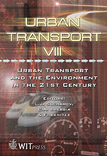EcoGest - Numerical Modelling Of The Dynamic, Fuel Consumption And Tailpipe Emissions Of Vehicles Equipped With Spark Ignition Engines
Price
Free (open access)
Transaction
Volume
60
Pages
10
Published
2002
Size
545 kb
Paper DOI
10.2495/UT020511
Copyright
WIT Press
Author(s)
C.M. Silva, T.L. Farias & J.M.C. Mendes-Lopes
Abstract
A numerical code capable of predicting the dynamic and environmental performances of vehicles is presented. The program named EcoGest, solves the dynamic laws of vehicles for specific acceleration and deceleration curves of typical driving modes. Main inputs of EcoGest are the type of driving mode, vehicle characteristics, number of passengers, time spent at idle and the route -characterized by the topography, number and localization of stop signs and maximum allowed speed. Based on those inputs EcoGest is capable of calculating along the trip the localization of the vehicle, vehicle velocity, position of the accelerator pedal, gearbox selection, and the engine rotation speed. In addition, using the throttle position and the engine speed, EcoGest is capable of estimating instantaneous fuel consumption as well as instantaneous and average NOx, CO, CO2 and HC exhaust emissions. These calculations are done using emissions and fuel consumption distribution maps as a function of engine speed and throttle position. These maps can be obtained either numerically, or experimentally. For numerical data, due to the lack of experimental data for a large range of engines and running conditions, a numerical model, named MotorIST, was developed which simulates the real thermodynamic cycle of a four stroke spark ignition engine were a full discretization in time is adopted. Instead of performing a driving simulation for specific acceleration and deceleration curves of typical driving modes (slow, normal and fast), EcoGest can calculate the driving parameters (such as position of the accelerator pedal and engine rotation speed needed for the calculation of fuel consumption and tailpipe emissions) from a given driving cycle (speed against time), position of speed gear box chosen by the driver along the driving time, vehicle characteristics and number of passengers inside.
Keywords





